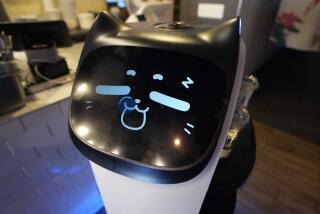Hopes to Ease Long Lines With Teller Machines : Postal Service Banking on Automation
- Share via
WASHINGTON — Americans may be spared from the long lines at post offices if the Postal Service goes national with its latest creation--automated postal tellers.
The high-tech “Autopost” machines, similar to the automated tellers popularized by the banking industry, could become a standard offering in thousands of post offices across the country by the 1990s.
The Postal Service will begin testing the “Autopost” and the “Infopost”--a sleek 6-foot machine that answers questions about mail services on a colorful video screen--later this year.
Adopted New Motto
Postal engineer Ray Morgan says the service has adopted a new motto that should take it comfortably through the 1990s: “The only thing more expensive than new technology is no technology.”
The U.S. Postal Service fell behind many industrialized nations in the 1970s and struggled through most of the 1980s to evolve from a mechanized system to a more automated operation.
The push for the 1990s will be to expand the use of automation, with machines like the Autopost and Infopost paving the way.
To use the Autopost, customers place a letter or package on a silver tray and an overhead video screen reveals how much postage they need to put on the item. The sender then inserts the appropriate amount of money in a cash slot and the peel-off postage, change and a computerized receipt drop down a metal chute.
The machine accepts any assortment of change or dollar bills up to $20 and the automated postal teller can be used with no money at all if customers have a bank card.
Gives Data on Costs
Unlike the Autopost, the Infopost does not perform any transactions, but it provides customers with information on the kinds of mail service available and tells them which method of sending a package will be cheaper or faster, depending on their priorities.
The Infopost has an audio component that speaks to the customer in English or Spanish and the machine spits out a computerized printout for patrons who want to keep its listing of prices and mailing options.
“We tried to make it as user friendly and as simple as possible for anyone who walks into the post office,” said Debra Schweitzer, a designer for Online Computer Systems, the company that helped develop the machines.
To ease the fears of customers who are still uncomfortable with the video age, Schweitzer and her co-workers developed a system that could be used by anyone with a third-grade education.
If customers flock to the machines when they are tested this fall in the Washington area, the Postal Service envisions placing them in thousands of post offices around the country. The machines likely would be kept in a part of the post office where customers would have 24-hour access to them.
Three Years of Study
Mason Lilly, program director of the service’s technology department, said officials spent three years studying the feasibility of the machines and about $5 million developing them.
“The banking industry did the footwork for us,” Lilly said. “The success of automated teller machines gave us the incentive we could do something like this, something more sophisticated than a vending machine.”
“We have a generation of kids coming along that are turned on to this thing, or at least not turned off,” he added.
Officials say it’s too early to predict how much money the machines will save the postal service, but they expect that the devices will at least help them keep pace with the expanding volume of mail--expected to reach 250 billion pieces a year by the year 2,000.
More to Read
Inside the business of entertainment
The Wide Shot brings you news, analysis and insights on everything from streaming wars to production — and what it all means for the future.
You may occasionally receive promotional content from the Los Angeles Times.










